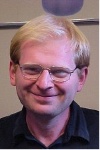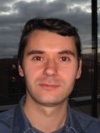Keynote Speakers

|
Craig Gotsman is a professor at the Center for Graphics and
Geometric Computing (CGGC), Computer Science Department at Technion.
He is also Hewlett-Packard Chair in Computer Engineering.
His research is in the area of computer graphics.
His homepage is: http://www.cs.technion.ac.il/~gotsman
Geometry Processing for Computer Graphics
The field of geometry processing has developed over the past decade into
a mature sub-field, alongside rendering, of computer graphics and geometric
modeling.
The speaker will survey a number of key techniques in geometry processing
and their application to computer graphics.
|

|
Alexei (Alyosha) Efros is an assistant professor at the Robotics Institute
and the Computer Science Department at Carnegie Mellon University.
His research is in the area of computer vision and computer graphics,
especially at the intersection of the two. He is particularly interested in
using data-driven techniques to tackle problems which are very hard to
model parametrically but where large quantities of data are readily
available. Alyosha received his Ph.D. in 2003 from the University of
California, Berkeley and spent the following year as a fine fellow at
Oxford, England. Alyosha is a recipient of the NSF CAREER award (2006),
the Sloan Fellowship (2008), and the Guggenheim Fellowship (2008).
His homepage is: http://www.cs.cmu.edu/~efros/
Using Data to "Brute Force" Hard Problems in Computational Photography
(abstract pending)
|

|
Karol Myszkowski is a professor in Max-Planck Institute for Informatics,
Germany. His research is in the area of computer graphics. He is
particularly interested in high dynamic range imaging, realistic image
synthesis and global illumination, perception issues in computer graphics
applications.
His homepage is: http://www.mpi-inf.mpg.de/~karol/
Perception Issues in Rendering and High Dynamic Range Imaging
The knowledge of human visual system (HVS) enables more efficient image
rendering by focusing the computation on visible scene details and by
overcoming physical constraints of display devices.In this talk we present
a number of successful examples of embedding HVS models into real-time
image rendering and display pipelines. In particular, we discuss the
problem of improving the appearance of highlights and light sources by
boosting their apparent brightness using our temporal glare technique.
Also, we show how to overcome physical contrast limitations of display
device by using our 3D unsharp masking technique to boost the apparent
contrast. On the image display side, we briefly overview our techniques
for tone mapping of High Dynamic Range (HDR) images. Finally, we present
our solutions for image quality evaluation including a difficult case of
image pairs with substantially different dynamic range.
|

|
Vladimir Kolmogorov received an MS degree from the Moscow Institute of
Physics and Technology in Applied Mathematics and Physics and a PhD degree
in Computer Science from Cornell University. After spending two years as
an Associate Researcher at Microsoft Research, Cambridge, he joined
University College London as a Lecturer. Vladimir's research is in the area
of computer vision. More specifically, he focuses on graphical models,
optimization algorithms for Markov Random Fields, and their applications to
image segmentation, stereo and other vision problems.His papers received
best paper award at ECCV 2002, best paper honourable mention award at
CVPR 2005 and an honorable mention, outstanding student paper award (to
M. Pawan Kumar) at NIPS 2007. He holds the Royal Academy of
Engineering/EPSRC Research Fellowship.
His homepage is: http://www.cs.ucl.ac.uk/staff/V.Kolmogorov/
A Global Perspective on MAP Inference for Low-Level Vision
[link]
In recent years the Markov Random Field (MRF) has become the de facto
probabilistic model for low-level vision applications. However, in a
maximum a posteriori (MAP) framework, MRFs inherently encourage delta
function marginal statistics. By contrast, many low-level vision problems
have heavy tailed marginal statistics, making the MAP-MRF framework
unsuitable. I will describe a more general Marginal Probability Field (MPF),
which can be used to encourage arbitrary marginal statistics.
Computing MAP solutions in an MPF is a challenging NP-hard optimization
problem, which received relatively little attention in the literature.
I will present several new results based around dual-decomposition and
a modified min-cost flow algorithm. I will demonstrate the benefits of MPFs
over MRFs on several applications, including image denoising and texture
synthesis.
Joint work with Olly Woodford and Carsten Rother.
|
|

